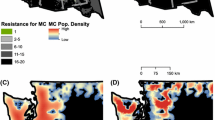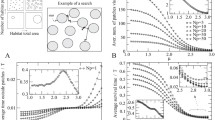Abstract
Understanding the impacts of habitat fragmentation on dispersal is an important issue in landscape and conservation ecology. Here I examine the effects of fine- to broad-scale patterns in landscape structure on dispersal success of organisms with differing life-history traits. An individual-based model was used to simulate dispersal of amphibian-like species whose movements were driven by land cover and moisture conditions. To systematically control spatial pattern, a landscape model was created by merging simulated land cover maps with synthetic topographic surfaces. Landscapes varied in topographic roughness and spatial contagion in agriculture and urban land cover. Simulations included three different species types that varied in their maximum potential dispersal distances by 1-, 2-, or 4-fold. Two sets of simulations addressed effects of varying aspects of landscape structure on dispersal success. In the first set of simulations, which incorporated variable distances between breeding patches, dispersal success was lowest for all species types when anthropogenic cover was patchily distributed. In the second set, with interpatch distances held constant as landscape composition varied, dispersal success decreased as anthropogenic cover became spatially contagious. Both sets revealed strong main effects of species characteristics, interpatch distances and landscape composition on dispersal success; furthermore, scale-dependent patterns in land cover and moisture gradients had a stronger effect on longer- than shorter-ranging species types. Taken together, these simulations suggest that heuristic conservation strategies could potentially be developed based on important but limited life history information.





Similar content being viewed by others
References
Allen TFH, Hoekstra TW (1992) Toward a unified ecology. Columbia University Press, New York
Anderson GS, Danielson BJ (1997) The effects of landscape composition and physiognomy on metapopulation size: the role of corridors. Landsc Ecol 12:261–271
Bascompte J, Solé RV (1996) Habitat fragmentation and extinction thresholds in spatially explicit models. J Anim Ecol 65:465–473
Bender DJ, Fahrig L (2005 Matrix structure obscures the relationship between interpatch movement and patch size and isolation. Ecology 86:1023–1033
Beven KJ, Kirkby MJ (1979) A physically based, variable contributing area model of basin hydrology. Hydrol Sci Bull 24:43–69
deMaynadier PG, Hunter ML (1998) Effects of silvicultural edges on the distribution and abundance of amphibians in Maine. Conserv Biol 12:340–352
ESRI (1999) ArcDoc Version 8.0.1. Environmental Systems Research Institute, Redlands
Fahrig L (1988) A general model of populations in patchy habitats. Appl Math Comput 27:53–66
Fahrig L (1997) Relative effects of habitat loss and fragmentation on population extinction. J Wildlife Manage 61:603–610
Fahrig L, Merriam G (1985) Habitat patch connectivity and population survival. Ecology 66:1762–1768
Franklin J (1995) Predictive vegetation mapping: geographic modelling of biospatial patterns in relation to environmental gradients. Prog Phys Geogr 19:474–499
Gardner RH (1999) RULE: a program for the generation of random maps and the analysis of spatial patterns. In: Klopatek JM, Gardner RH (eds) Landscape ecological analysis: issues and applications. Springer-Verlag, New York, pp 280–303
Gardner RH, Gustafson EJ (2004) Simulating dispersal of reintroduced species within heterogeneous landscapes. Ecol Model 171:339–358
Gardner RH, Milne BT, Turner MG, O’Neill RV (1987) Neutral models for the analysis of broad-scale landscape pattern. Landsc Ecol 1:19–28
Gardner RH, O’Neill RV, Turner MG (1993) Ecological implications of landscape fragmentation. In: Pickett STA, McDonnell MJ (eds) Humans as components of ecosystems: the ecology of subtle human effects and populated areas. Springer-Verlag, New York, pp 208–226
Gibbs JP (1998) Distribution of woodland amphibians along a forest fragmentation gradient. Landsc Ecol 13:263–268
Gustafson EJ, Gardner RH (1996) The effect of landscape heterogeneity on the probability of patch colonization. Ecology 77:94–107
Keitt TH, Urban DL, Milne BT (1997) Detecting critical scales in fragmented landscapes. Conserv Ecol 1:4. Available from http://www.ecologyandsociety.org/vol1/iss1/art4/
King AW, With KA (2002) Dispersal success on spatially structured landscapes: when do spatial pattern and dispersal behavior really matter? Ecol Model 147:23–39
Levin SA (1992) The problem of pattern and scale in ecology. Ecology 73:1943–1967
Madison DM (1997) The emigration of radio-implanted spotted salamanders, Ambystoma maculatum. J Herpetol 31:542–551
MathSoft (1999) S-Plus, Version 5.0. MathSoft, Inc., Redlands
McIntyre NE, Wiens JA (1999) Interactions between habitat abundance and configuration: Experimental validation of some predictions from percolation theory. Oikos 86:129–137
Michener WK, Baerwald TJ, Firth P, Palmer MA, Rosenberger JL, Sandlin EA, Zimmerman H (2001) Defining and unraveling biocomplexity. Bioscience 51:1018–1023
Opdam P (1990) Dispersal in fragmented populations: the key to survival. In: Bunce RGH, Howard DC (eds) Species dispersal in agricultural habitats. Belhaven Press, New York, pp 3–17
Pearson SM, Turner MG, Gardner RH, O’Neill RV (1996) An organism-based perspective of habitat fragmentation. In: Szaro RC, Johnson DW (eds) Biodiversity in managed landscapes: theory and practice. Oxford University Press, New York, pp 77–95
Perault DR, Lomolino MV (2000) Corridors and mammal community structure across a fragmented, old-growth forest landscape. Ecol Monogr 70:401–422
Plotnick RE, Gardner RH, O’Neill RV (1993) Lacunarity indexes as measures of landscape texture. Landsc Ecol 8:201–211
Plotnick RE, Gardner RH (2002) A general model for simulating the effects of landscape heterogeneity and disturbance on community patterns. Ecol Model 147:171–197
Pulliam HR (1988) Sources, sinks, and population regulation. Am Nat 132:652–661
Ricketts TH (2001) The matrix matters: effective isolation in fragmented landscapes Am Nat 158:87–99
Sinsch U (1992) Amphibians. In: Papi F (ed) Animal homing. Chapman and Hall, London, pp 213–233
Strogatz SH (2001) Exploring complex networks. Nature 410:268–276
Taylor PD, Fahrig L, Henein K, Merriam G (1993) Connectivity is a vital element of landscape structure. Oikos 68:571–572
Tischendorf L, Fahrig L (2000a) How should we measure landscape connectivity? Landsc Ecol 15:633–641
Tischendorf L, Fahrig L (2000b) On the usage and measurement of landscape connectivity. Oikos 90:7–19
Turchin P (1998) Quantitative analysis of movement: measuring and modeling population redistribution in animals and plants. Sinauer Associates, Inc., Sunderland
Walters S (2001) Landscape pattern and productivity effects on source–sink dynamics of deer populations. Ecol Model 143:17–32
Wiens JA (2001a) The landscape context of dispersal. In: Clobert J, Danchin E, Dhondt AA, Nichols JD (eds) Dispersal. Oxford University Press, Oxford, pp 96–109
Wiens JA (2001b) Understanding the problem of scale in experimental ecology. In: Gardner RH, Kemp WM, Kennedy VS, Petersen JE (eds) Scaling relations in experimental ecology. Columbia University Press, New York, pp 61–88
With KA (1994) Using fractal analysis to assess how species perceive landscape structure. Landsc Ecol 9:25–36
With KA (1997) The application of neutral landscape models in conservation biology. Conserv Biol 11:1069–1080
With KA, Cadaret SJ, Davis C (1999) Movement responses to patch structure in experimental fractal landscapes. Ecology 80:1340–1353
With KA, Crist TO (1995) Critical thresholds in species responses to landscape structure. Ecology 76:2446–2459
With KA, Gardner RH, Turner MG (1997) Landscape connectivity and population distributions in heterogeneous environments. Oikos 78:151–169
With KA, King AW (1997) The use and misuse of neutral landscape models in ecology. Oikos 79:219–229
With KA, King AW (1999a) Dispersal success on fractal landscapes: a consequence of lacunarity thresholds. Landsc Ecol 14:73–82
With KA, King AW (1999b) Extinction thresholds for species in fractal landscapes. Conserv Biol 13:314–326
Wolock DM (1995) Effects of subbasin size on topographic characteristics and simulated flow paths in Sleepers River Watershed, Vermont. Water Resour Res 31:1989–1997
Acknowledgements
I want to thank Robert Gardner, Philip Townsend, Steven Seagle, J. Edward Gates and Robert Costanza for providing invaluable guidance in conducting the present study. This research was partially funded by a fellowship from the National Network for Environmental Management Studies (NNEMS) Program, US Environmental Protection Agency (US EPA). Critical reviews by Jason Grear, Diane Nacci, Matthew Nicholson, and two anonymous reviewers proved most valuable in revising the manuscript. Although the research has been partly funded by the US EPA, it has not been subjected to Agency-level review, and therefore does not necessarily reflect the views of the Agency. Mention of commercial products does not constitute endorsement or recommendation for use. This is NHEERL contribution number AED-06-007.
Author information
Authors and Affiliations
Corresponding author
Rights and permissions
About this article
Cite this article
Walters, S. Modeling scale-dependent landscape pattern, dispersal, and connectivity from the perspective of the organism. Landscape Ecol 22, 867–881 (2007). https://doi.org/10.1007/s10980-006-9065-3
Received:
Accepted:
Published:
Issue Date:
DOI: https://doi.org/10.1007/s10980-006-9065-3




